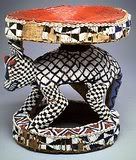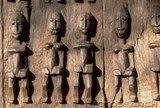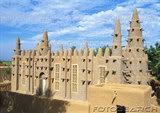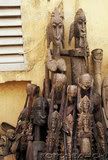Friday, June 1, 2007
African Roots of Humanity- Part I
BLACKHERBALS.COM
THE AFRICAN ROOTS OF HUMANITY AND CIVILIZATION
RUNOKO RASHIDI
http://blackherbals.com/african_roots
_of_humanity_and_ci.htm
INTRODUCTION
It has been said that "history is a light that illuminates the past and a key that unlocks the door to the future." This paper is designed to help reconnect and refocus the history and present conditions of the Global African Community from the periphery of our imaginations to the center of our attention, and is devoted to the review of what has been referred to as "That Other African." This is not the stereotypical African savage, but the African that first peopled the earth, and gave birth to or significantly influenced the world's oldest and most magnificent civilizations. This is the African that first entered Asia, Europe, Australia, the South Pacific, and the early Americas not as slave, but as master. We now know, based on recent scientific studies of DNA, that modern humanity originated in Africa, that Black people are the world's original people, and that all modern humans can ultimately trace their ancestral roots back to Africa. If not for the primordial migrations of early African people, humanity would have remained physically Africoid, and the rest of the world outside of the African continent absent of human life.
Our concern is not only with Africa as the cradle of human culture, but as the birthplace and the cradle of humanity itself. For a long time the cradle of humanity was "placed" in Asia. This was apparently done for at least two basic reasons: the ancient presence in Asia of all three major human ethnic types (Black, White, and Yellow); and the discovery of Homo erectus in Asia at a time when Africa had not yet become a significant target for palaeontological excavations.
Homo erectus, whose origins have been traced back to about 1.6 million years before present, was the first hominid to leave Africa. More than 500,000 years ago, having domesticated fire and possessing rudimentary methods of transporting food and water, Homo erectus, with physical characteristics distinctly marked by dark complexion and tightly curled hair, was ready to embark upon his Asia trek. Both the well known "Peking Man" and "Java Man" fossils are only regional variations of early, Africoid Homo erectus populations. The arrival of Homo erectus from Africa into Europe has been estimated at about 400,000 years ago.
In addition to Homo erectus, the Great Lakes region of East-Central Africa also produced the first modern human populations (Homo sapiens sapiens). New researches and discoveries in the relevant scientific fields confirm this. In 1986, for example, after a meticulous analysis of mitochondrial DNA, an elite group of scientists led by Oxford University's James S. Wainscoat, recorded the following statement: "The earliest fossils of anatomically modern man (Homo sapiens sapiens) have been found in Africa at Omo in Ethiopia, Border Cave [Ingwavuma] in South Africa and at Klasies River Mouth in South Africa. The data from the last site suggests that Homo sapiens sapiens was present in South Africa more than 100,000 years ago, and an adult mandible from Border Cave has been dated to about 90,000 years before present. Hence, it has been argued that the evolution of modern man took place in Africa. Our data are consistent with such a scheme, in which a founder population migrated from Africa and subsequently gave rise to all non-African populations."
In 1987, less than a year after the initial publication of their findings, Wainscoat was even more convinced of their validity. In a more specific report,Wainscoat noted that, "It seems likely that modern man emerged in Africa and...that subsequently a founder population left Africa and spread throughout Europe, Asia and the Americas."
Douglas Wallace, another scientist actively engaged in DNA research, adds that, "The scientist's Eve--subject of one of the most provocative theories in a decade--was more likely a dark-haired, black-skinned woman, roaming a hot savanna in search of food." According to Diop: "The man born in Africa was necessarily dark-skinned due to the considerable force of ultraviolet radiation in the equatorial belt. As he moved toward the more temperate climates, this man gradually lost his pigmentation by process of selection and adaptation."
Throughout the 1990s DNA research has continued and has given added weight to the African origins of humanity. As the direct result of migrations then, African people came to populate the rest of the world. There were different routes with varying degrees of difficulty that the migrants could have taken as they left the Great Lakes region. These routes include the Nile Valley, the Suez Isthmus into Asia, and the Straits of Gibraltar into Europe. It is in the light of these routes that the presence of modern humans in Asia, Europe, and, ultimately the Americas, can be traced.
GREAT AFRICAN CIVILIZATIONS: HISTORY, CULTURE & HERITAGE
Although it was Africa's Upper Nile Valley--the highly regarded Ethiopia ("land of the burnt-faced people"), that gave birth to the world's oldest monarchy of which we are informed (Ta-Seti), it is in pharaonic Egypt (ancient Kmt), the greatest nation of antiquity and Ethiopia's most celebrated offspring, that the tremendous volume of historical inquiry has been made. The world is enthralled by Kmt. And why should it be otherwise? When we examine Kemetic civilization we examine perhaps the proudest and loftiest accomplishments in the whole of human annals. Her list of achievements is extremely long and strikingly notable. Ancient Kmt has been, and probably will continue to be, the primary focus of our studies for some time to come.
These studies are demonstrating with rapidity and increasing precision that not only were Kmt's origins African, but that through the mass of her dynastic period (3250 to 341 B.C.E.), African people endowed with dark complexions, full lips, broad noses, and tightly-curled hair were dominant in both the general population and the reigning elite.
Modern Pharaohs of Nile Valley Studies
Of the recent towering figures in the struggle to completely eradicate the pervasive racial myths clinging to the origins of Kmt, two men in particular stand out. Cheikh Anta Diop, born in Diourbel, Senegal on December 29, 1923, was the founder and Director of the Radiocarbon Laboratory of the Fundamental Institute of Black Africa (IFAN) at the University of Dakar. Diop was a multi-disciplinary scholar who helped introduce an uncompromising and eminently systematic approach towards the study of Africa and the numerous civilizations that she has produced and influenced. Included among the effective range of methodologies utilized in his researches were: the study of human images; analyzes of the epidermis of royal Kemetic mummies for verification of their melanin content; osteological measurements and physical anthropology; comparison studies of Upper Egyptian and modern West African blood-groups; comparison studies demonstrating linguistic affinities and phonetic correspondences between Kemetic and West African languages; documentation of the divine epithets and ethnic designations employed by the Kamites themselves; investigations of Biblical testimonies pertaining to Kemetic race and culture; and investigations of early Greek and Roman eye-witness accounts concerning Kemetic ethnicity. Diop died on February 7, 1986.
Chancellor Williams, born December 22, 1898 in Bennetsville, South Carolina, is probably best known as the author of the 1971 publication, The Destruction of Black Civilization: Great Issues of a Race from 4500 B.C. to 2000 A.D. Uncompromising, broadly sweeping its range, and immensely powerful in its scope, there has probably been no other single book focusing on antiquity, particularly the Nile Valley, that has so profoundly affected the consciousness of the present generation of African-Americans. Williams began direct field studies in African history in 1956. The final field studies, which covered 26 countries and 105 language groups, were finished in 1964. Williams is a retired professor of African History at Howard University.
The Royal Dynasties of Kmt
While Narmer (ca. 3250 B.C.E.) is regarded as Kmt's first monarch, he may have seen himself as the culmination of a historical epoch, rather than the beginning. Narmer was the heir to at least a millennium of African brilliance, and assumed charge of an already advanced and highly-evolved society. The Old Kingdom (2260-2180 B.C.E.), comprising Dynasties III through VI, witnessed a real flowering of Kemetic culture. It produced such personalities as: Zoser, Imhotep, Nae-maet Sneferu, Khufu, Khafre, Menkaure, Hesyre, Ptah-hotep, and Neferkare Pepi II--whose 94 years on the throne remains the longest single reign in world history.
The Old Kingdom was also the famous epoch of pyramid building. The great pyramids are arguably the world's most enduring expressions of architectural prowess. The invading Arabs of post-pharaonic Egypt were so awed by the pyramids that they coined the expression: "Men fear time, but time fears the pyramids." Jean Francois Champollion, regarded by many as the chief figure in the decipherment of Kemetic hieroglyphs, remarked that "the Egyptians built like men a hundred feet tall."
Ancient Kmt's Middle Kingdom, the significant period in Kemetic history encompassing Dynasties XI (ca. 2130-1991 B.C.E.) and XII (1991-1786 B.C.E.), was one of the most remarkable epochs in the long history of the African people. Kmt's Middle Kingdom was founded by nobles from Southern Kmt--the Mentuhoteps and Intefs--a distinguished and aggressive family of African nobles from Waset, the then little-known city in Kmt's Scepter nome that the Greeks were to call Thebes.
With Nebhepetre Mentuhotep II's assumption of the Upper Kemetic throne around 2060 B.C.E. began another sustained, and ultimately successful, drive for the reunification of all Kmt. Like the Old Kingdom before it, the Middle Kingdom is especially noteworthy for its tremendous engineering and architectural achievements. Nymare Amenemhet III (1843-1797 B.C.E.), for example, raised two major pyramids--at Dahshur and Hawara. The Hawara pyramid possessed a sepulchral chamber of yellow quartzite--22 feet long, eight feet wide and six feet high. The total weight of the chamber was 110 tons. The roof of the chamber itself was composed of three massive pieces of yellow quartzite--with a combined weight of 45 tons.
Around Lake Moeris in the Faiyum Oasis of Middle Kmt was constructed a vast embankment 27 miles long that secured more than 27,000 acres of fertile land for cultivation. At the Nile's entrance to the Lake was established a great dam, which regulated the mighty river's flow, and thus minimized the risks of a poor harvest. Amenemhet's officials at the Kemetic fortress of Semneh, located at the second cataract, recorded the height of the Nile on the rocks there.
North of Lake Moeris were placed stone platforms filled with earth. Atop these were added two huge pedestals, each of which held a colossi of the king, 39 feet high. Carved from quartzite and polished until they shone brilliantly, they glittered across Lake Moeris. Fragments of these statues can still be seen in the Ashmolean Museum at Oxford.
On the south side of the Lake stood the Labyrinth. The Labyrinth may have been the largest single building in world history. The Labyrinth contained 3000 rooms, 1500 below the ground and 1500 above. The building itself was 800 by 1000 feet. Herodotus (ca. 450 B.C.E.) said that it surpassed the pyramids, and noted that, "It is beyond my ability to describe. It must have cost more in labor and money than all of the walls and public works of the Greeks put together."
W. M. Flinders Petrie (1853-1942), who excavated the site in 1888, provided additional information on this building of buildings:
"The mere figures will not signify readily to the mind the vast extent of construction; but when we compare it with the greatest of the other Egyptian temples it could be somewhat realized. On that space could be erected the great hall of Karnak, and all the successive temples adjoining it, and the great court and pylons of it; and also the temple of Mut, and also the two great temples of Luxor; and still there would be room for the whole of the Ramesseum. In short, all the temples on the east bank of Thebes, and one of the largest on the west bank, might be placed together in the one area....Here we certainly have a site worthy of the renown which the Labyrinth acquired."
William Leo Hansberry considered Dynasty XVIII "one of the greatest, if not the greatest, royal family to ever sit on any throne anywhere at any time." Kmt's Dynasty XVIII began about 1580 B.C.E. Under the leadership of Nebpehtyre Ahmose I and his highly venerated wife and queen, Ahmose-Nefertari, the African armies grew strong enough to eject the despised Hyksos ("shepherd kings")--Kmt's first foreign invaders. After having experienced an 150 year period of foreign occupation, the Kamites vowed "never again" and quickly proceeded to conquer the whole of Western Asia. The spoils of war that flowed into her treasuries catapulted Kmt into position as the world's leading superpower. In addition to Ahmose I and Ahmose-Nefertari, Dynasty XVIII is the period of such notables as: Djeserkare Amenhotep I, Akheperkare Thutmose I, Makare Hatshepsut, Senemut, Menkheperre Thutmose III, Nebmare Amenhotep III, Queen Tiye, Akhenaten and Nebkheprure Tutankamen.
Cheikh Anta Diop believed that "The highest point of Egyptian history was the Nineteenth Dynasty of Ramses II." The Nineteenth Dynasty was indeed an extraordinarily pivotal phase in African history. Akhenaten's determined efforts towards a social-religious revolution several decades earlier had effectively polarized the Kemetic state. A tremendous power struggle ensued with the monarchy on one side, and the priesthood on the other. The result of this conflict of interest was a prolonged period of political instability. Many precincts within the vast regions conquered during the military campaigns of the Dynasty XVIII warrior-kings had been lost. The nation's military readiness and national prestige had sharply declined, a situation that the enemies of Kmt observed with keen interest and growing anticipation. These hostile forces, including numerous Semitic and Indo-European speaking elements, rose in defiance of their African overlords, and instituted a series of steady attacks that threatened Kmt's very existence.
The sixty-seven year reign of Ramses II was for Kmt an era of general prosperity, stable government and extensive building projects. Ancient gods like Ptah, Ra and Set were elevated to high status. The worship of Amen was restored and his priests reinstated. Major wars were fought with the Libyans, Hittites and their allies. Wondrous new temples from Nubia to the Kemetic Delta were carved out of the naked cliffs. Splendid tombs in the hills of western Waset and Aabdju were constructed, renovated and beautified. The new Kemetic city of Pi-Ramses made its impressive debut.
Ramses was actually deified in his own lifetime, and through the unrelenting projection of his own incomparable personality, he made the name Ramses synonymous with kingship for centuries. Ramses II was truly great. He was the towering figure of his age, and established the models and set the standards that others used to rule by. In regards to the ethnicity of Ramses, Diop expressed in unmistakable language that:
"Ramses II was not leucoderm and could have been even less red-haired, because he reigned over a people who instantly massacred red-haired people as soon as they met them, even in the street; these people were considered as strange beings, unhealthy, bearers of bad luck and unfit for life....Ramses II is black. Let's let him sleep in his black skin, for eternity."
Ramses initiated enormous building activities in Nubia. He commissioned temples at Beit-el-Wali, Gerf Hussein, Wadi-es-Sebua, Derr, Abu Simbel and Aksha in Ta-Seti (Lower Nubia), and at Amara and Barkal in Upper Nubia. The temple of Abu Simbel, one of the largest rock-cut structures in the world, is no doubt a unique piece of architectural work. It is hewn into a mountain of sandstone rock on the left bank of the Nile that was held sacred long before the great Ramses' temple was cut there. It was dedicated to Ra-Harakhte, the god of the rising sun, who is represented as a man with the head of a falcon wearing the solar disc. It is a masterpiece of architectural design and engineering. The whole purpose and position of the temple was devoted to the adoration of the sun at dawn, and it was only at sunrise at certain times of the year that the vast interior was illuminated, when the light penetrated the sanctuary. It must have been for the faithful an unforgettable experience to stand in the main hall at dawn, and watch the life-giving rays of the sun gradually penetrate into the majestic inner sanctuary of an ancient religion.
Having lived vigorously for more than nine decades, Ramses II died in the second month of his 67th regnal year. In actuality however, there was no death in the African way of thinking; only gradual decay and periodic renewal. Kmt was perhaps the earliest nation to clearly articulate the purely African notions of resurrection and immortality. As one writer succinctly stated, within the context of Kmt, "If Osiris, the Nile, and all vegetation, might rise again, so might man." Man could rise, but only if he made God's words, which were truth, justice and righteousness, manifest on earth. This was fundamental to the African psyche.
Although Kmt declined in prominence following the end of the New Kingdom, the Africans of the ancestral south, Kush, remained strong and made a final stand during against foreign invasions during Dynasty XXV (750-656 B.C.E.). The rulers of Dynasty XXV--Piankhi, Shabaka, Shabataka, Taharqa and Tanutamon--sparked a powerful movement of cultural revival and national resurgence in Kmt. But the entire history of the dynasty was a supreme effort to form a united front against foreign invaders. For nearly one hundred and fifty years the strong African forces held their own, but in 661 B.C.E. the Assyrian army attacked Kmt and pillaged the city of Waset. According to Diop, "The fall of the most venerated city of all antiquity aroused deep emotion in the world of that time and marked the end of the Nubian Sudanese or Twenty-Fifth Ethiopian Dynasty. That date also marked the decline of Black political supremacy in antiquity and history."
The challenge to the African global community to rise up and aggressively reclaim its heritage of great civilizations must be seen as an integral part of the Pan-African liberation movement. Kmt was the heart and soul of Africa, and we only need glance at her regal splendors to measure our true descent from power. We must see in Kmt the knowledge that what African people did, African people can do. In this manner, the immortal accomplishments of our illustrious ancestors are resurrected, and the distant past not only merges with the present, but outlines the possibilities of the future.
Labels: African Roots of Humanity - Part I
Subscribe to Comments [Atom]







